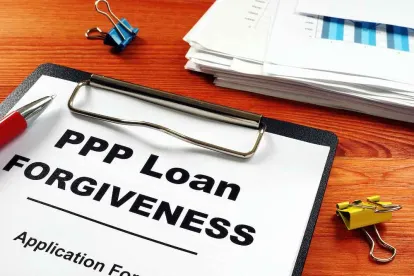On December 27, 2020, President Trump signed into law Congress’s spending bill, the Consolidated Appropriations Act (CAA), 2021, which included the Additional Coronavirus Response and Relief (ACRR) provisions that modified the Small Business Administration’s (SBA) Paycheck Protection Program (PPP). The PPP, a loan program designed to provide a direct incentive to businesses to retain their employees, was enacted under the Coronavirus Aid, Relief, and Economic Security (CARES) Act. PPP borrowers are eligible for loan forgiveness if the funds are used for eligible payroll and non-payroll costs.
The ACRR provisions extended the covered period for all new PPP loans through March 31, 2021, and required the SBA to publish additional implementing guidance. On January 7, 2021, the SBA released two interim final rules (which we will cover in a forthcoming article) providing guidance on the PPP extension and expansion and on the new PPP second draw loans.
This article summarizes the important ACRR modifications to the PPP that employers may want to know. All references to a section refer to the ACRR.
Tax Treatment of PPP Loans
A key issue unaddressed in the CARES Act was the tax treatment of the forgiveness of PPP loans. Under Section 276, gross income does not include any amount of a PPP loan that is forgiven. Further, deductions are allowed on otherwise allowable deductible expenses paid with proceeds of a PPP loan that is forgiven. No tax attribute is reduced, or basis of an asset is increased, due to the exclusion from gross income of a debt forgiven under the PPP. These tax provisions apply to existing and future PPP loans. On January 6, 2021, the Internal Revenue Service (IRS) issued Revenue Ruling 2021-02, which superseded previous IRS guidance that was contrary to Section 276, and it provides IRS authority supporting the provisions of Section 276.
Selected Provisions of the Continuation of the PPP
Expansion of Expenses Eligible for Loan Forgiveness
The ACRR provisions require borrowers to use at least 60 percent of PPP loan proceeds for payroll costs and 40 percent of the proceeds on eligible non-payroll costs to receive full loan forgiveness. The ACRR provisions also expand the expenses that qualify as eligible payroll and non-payroll costs. Section 308 clarifies that payroll costs include payments for employer-provided benefits, including group life insurance, disability, vision, and dental. Additionally, Section 304 defines and expands non-payroll costs to include the following:
-
Covered operations expenditures: “payment for any business software or cloud computing service that facilitates business operations, product or service delivery, the processing, payment, or tracking of payroll expenses, human resources, sales and billing functions or accounting or tracking of supplies, inventory, records and expenses.”
-
Covered property damages costs: “cost[s] related to property damage and vandalism or looting due to public disturbance that occurred during 2020 not covered by insurance or other compensation.”
-
Covered supplier costs: costs paid by a borrower for goods, made under a contract, order, or purchased order in effect prior to taking out the loan that “are essential to the operations of the [borrower] at the time at which the expenditure was made.”
Supplier costs include costs of “perishable goods, in effect before or at any time during the covered period with respect to the applicable covered loan.”
-
Covered worker protection expenditures: operating or capital expenditures to facilitate the loan recipient’s compliance with federal health and safety guidelines or equivalent state and local guidance related to the COVID-19 national emergency beginning on March 1, 2020, through the expiration of the national emergency declaration.
The expanded forgivable expenses may be utilized by borrowers of PPP loans made before or after the enactment of these provisions, except for loans already forgiven.
Hold Harmless Provisions
Section 305 provides that a lender who “acts in good faith relating to loan origination or forgiveness” will be held harmless. This provision applies to initial or second draw PPP loans.
Covered Period for Forgiveness
Section 306 allows a borrower to elect when the covered period will end by selecting a date between 8 and 24 weeks after the date of origination. Previously, borrowers could only elect either an 8- or 24-week period.
Simplified Loan Forgiveness Application for Small Loans
Section 307 provides a simplified forgiveness application for PPP loans under $150,000. The key provisions include the following:
-
Loans are forgiven in full if a borrower submits a signed certification to the lender that is under one page in length.
-
The certification must describe the number of employees the employer was able to retain due to the loan, give an estimate of the total loan amount spent on payroll costs, and state the loan total.
-
Borrowers are required to retain employment records for four years and other records for three years after submission of the application form.
The SBA is required to create a simplified form within 24 days after enactment of these provisions. The simplified application provisions apply to loans under $150,000 made before, on, or after the enactment of these provisions, including loan forgiveness.
Demographic Information
Section 309 requires the SBA to include a “voluntary demographics” section on initial and second draw PPP loan application forms. This section will request various information, including the sex, race, ethnicity, and veteran status of the borrowing entity’s owner. All loan applications on and after the enactment of these provisions must contain the demographics section, though completing such information is voluntary on the part of the borrower.
Clarification of and Additional Limitations on Eligibility
Section 310 clarifies that a business that was not in operation on February 15, 2020, is ineligible for initial and second draw PPP loans. Shutter Venue Operator Grant recipients (i.e., theatrical producers, museum operators, motion picture theatre operators, etc.) are ineligible for PPP loans.
PPP Second Draw Loans
Section 311 creates a second draw loan for smaller businesses with a maximum amount of $2 million. Unlike the first draw loans, which generally allowed businesses with up to 500 employees to obtain a loan, eligible businesses for the second draw loans may not have more than 300 employees. Eligible businesses must have used or will use the full amount of their first PPP loan and demonstrate at least a 25 percent reduction in gross receipts in any quarter of 2020 relative to the same quarter in 2019. There are special rules on the reduction in gross receipts for entities that did not exist for some or all of 2019. Eligible businesses include certain nonprofit organizations, housing cooperatives, veteran organizations, tribal businesses, sole proprietorships, and independent contractors.
Examples of ineligible entities include the following:
-
Financial business primarily engaged in the business of lending
-
Entities involved in political and lobbying activities
-
Entities affiliated with entities in the People’s Republic of China
-
Private clubs and businesses which limit the number of memberships for reasons other than capacity
-
Government-owned entities (except for businesses owned or controlled by a Native American tribe)
-
Businesses principally engaged in teaching, instructing, counseling or indoctrinating religion or religious beliefs
Second Draw Loan Terms
Borrowers may receive a loan amount for up to 2.5 times the average monthly payroll costs in the one year prior to the loan or calendar year, but not to exceed $2 million. Certain entities in industries assigned a North American Industry Classification System (NAICS) code of 72 Accommodation and Food Services (e.g., hotels and restaurants) may receive loans of up to 3.5 times the average monthly payroll costs. An eligible entity may only receive one PPP second draw loan.
Loan Forgiveness
Borrowers are eligible forgiveness for loans equal to the sum of their payroll costs and for non-payroll costs for covered mortgages, rents, utility payments, covered operational expenditures, covered property damage costs, covered supplier costs, and covered worker protection expenditures incurred during the covered periods of the loans. The 60/40 cost allocation between payroll costs and non-payroll costs to receive full forgiveness remains the same.
Industry-Specific PPP Provisions
The following sections provide provisions applicable to specific industries:
-
Section 313—PPP loans for farmers and ranchers: establishes a specific loan calculation for maximum loans for farmers and ranchers.
-
Section 314—farm credit system institutions: allows these institutions to make loans under the PPP.
-
Section 315—definition of seasonal employers: seasonal employers are eligible recipients that operate for no more than seven months in a calendar year or have earned no more than one-third of their gross receipts in any six months in the prior calendar year.
-
Section 316—housing cooperative: PPP eligibility extends to housing cooperatives that employ no more than 300






 />i
/>i
